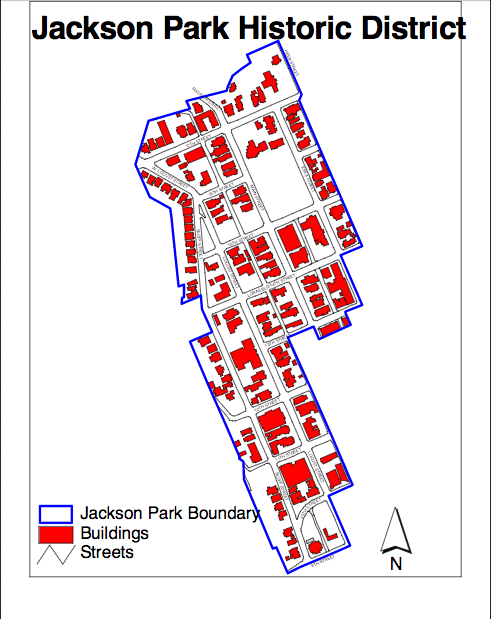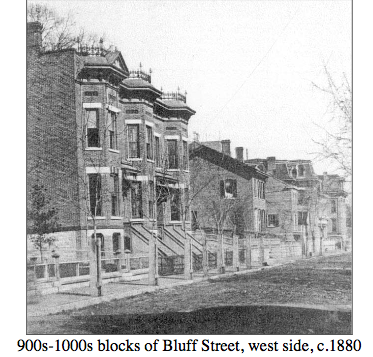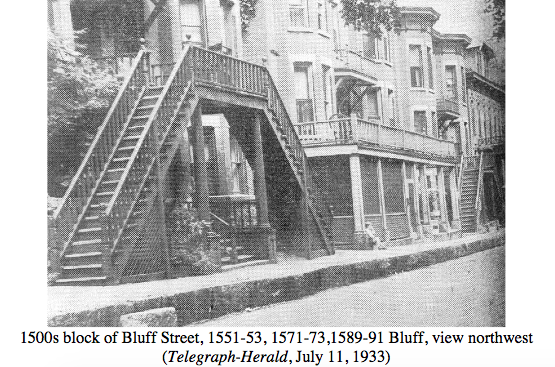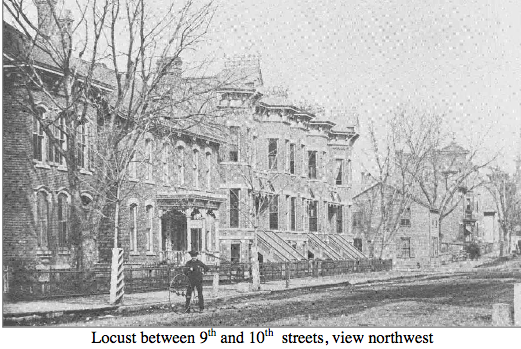Encyclopedia Dubuque
"Encyclopedia Dubuque is the online authority for all things Dubuque, written by the people who know the city best.”
Marshall Cohen—researcher and producer, CNN
Affiliated with the Local History Network of the State Historical Society of Iowa, and the Iowa Museum Association.
JACKSON PARK HISTORICAL DISTRICT
JACKSON PARK HISTORICAL DISTRICT. Note: The following information comes directly from the Jackson Park Historic District, Phase IV District report written by James E. Jacobsen for History Pays! Historic Preservation Consulting Firm of Des Moines, Iowa, 2003. This abridged version is used to give a brief view of the district's history. For the full report see: http://www.cityofdubuque.org/1475/Historic-Reports
The district is fairly remarkable for its overall flatness. For the most part there is little perception that the district is anything but level. Stone retaining walls are less common in this area and are lower in profile. Jackson Park, on its southeast corner, does have a raised plateau profile with retaining walls on its southern and eastern sides. Ground levels are steeply pitched along the western and northern peripheries of the district and they decline from west to east
Jackson Park has not witnessed the same commercial development and attending restoration efforts as has the Cathedral District. Indeed it was this transformation, beginning in the early 1970s in the West Fourth Street area that began the city’s historic preservation program.
A number of very substantial restoration efforts have been undertaken. The most notable project involves a complete restoration of 1492 Locust Street, the landmark Benjamin B. Richards House. Several other restorations are now underway (971 Bluff, 1145 Locust). 1146 Grove Terrace is a brick cottage that has had its aluminum siding removed. The properties at 1335-37, 1192, 1212 Locust and 315, 366, and 365 West Locust have had restoration efforts. A number of funeral homes have undertaken restoration efforts. BEHR'S FUNERAL HOME removed the notorious metal canopy from 1491 Main Street and the company is building a substantial brick and stone brick carriage house behind the same property that replaces a frame one. The reality of the district is that given that the vast majority of the buildings are of brick construction, the level of integrity overall is most impressive. There are relatively few new buildings apart from several that are unfortunately large and prominently placed.
Jackson Park contrasts starkly with Cathedral District with regard to churches. The latter never had any churches within its boundaries apart from the cathedral. In contrast this district included ten different churches (German Methodist Episcopal, Lutheran, Catholic, three Presbyterian, Christian Science, Christian, and Congregational, Episcopalian), was within a block of two others (Methodist and Baptist at West 12th and Main). There were also two Catholic schools (St. Patrick and St. Joseph Academy) and the first female seminary established west of the Mississippi River. Just one of the Presbyterian churches survives and there are seven surviving church buildings, one of which (Christian Science) is no longer used as a church. Clearly the two most significant church edifices are St. Patrick (1867), the First Congregational Church (1856), and ST. JOHN'S EPISCOPAL CHURCH. The German presence, presumably principally located in the northeast portion of the district, is represented by the First German Presbyterian Church (1892) and the German Methodist Episcopal Church and its rectory (c.1887), both of which are on the north end of Iowa Street. While not a church related institution initially, the German Theological Seminary (1856) is a very rare and early example of the Gothic Revival style, executed in an institutional design. The explosion in the establishment of Catholic institutions took place in the late 1870s.
The district was well served by the streetcar system with Main Street serving as the trunk line. It was double tracked in 1883 (Herald, July 12, 1883). The line turned east along the south side of JACKSON PARK where it joined the Clay Street/Central Avenue line northward. A second branch turned both east and west at West 13th Street, connecting to a Locust/West Locust line and again to the aforementioned Clay Street line. West Eight Street was a principal east/west business and shipping thoroughfare, and consequently also was tracked. A number of the principal churches fronted on the Main and West 15th street lines. It is commonly assumed that these lines attracted the better buildings and enhanced adjacent land values. The obverse of this assumption is the fact that property owners in Dubuque commonly opposed double tracking and that tracks were an intrusive presence to other traffic.
The original nomination described a generally northward expansion, with the northern terminus of construction falling below West 13th Street and east of Iowa Street as of the late 1860s. By the early 1880s the only undeveloped areas were that north of Jackson Park and West 11th Street. There was a scattering of buildings, likely mostly early frame ones, throughout the district and these disappeared over time. Several brick cottages lined the alley between Main and Locust, and north of West 14th Street.
The delayed development of West 17th Street might have been caused by its tendency to flash flood after heavy rains. Its protection was a major city issue in mid-1876 following the disastrous flood of July 4th of that year. That flood carved a 40’ deep chasm below the Seminary building and an eight to ten foot deep gully along the length of the street. Adjoining buildings were nearly undermined and the Seminary Hill stonewall was destroyed. Heated public meetings considered how best to permanently fix the street. Frederick WEIGEL and Thos. Finn wanted a concave street surface. John Bush and Mr. Mertz wanted an open sewer as a street surface with cross street bridges. Edward LANGWORTHY proposed a comprehensive $50,000 project that would have fixed the entire north end of the city. William REBMAN wanted stone side walls with bluff rock backfill. Thomas Cavanaugh suggested sidewalls of pilings and planks. Repair work was underway by October, likely following the city engineer’s recommendations. Fourteenth Street was also a major drainage for the bluffs and it gained a storm sewer in 1886.
Continued mining on Seminary Hill was also a hindrance to development. A major new LEAD strike was reported there in late 1893 when graders struck large chunks of “mineral” too large for two men to move (Telegraph, October 10, 1893).
The district streets remained unpaved until quite late. Locust, between West 10th and West 17th STREETS, was paved with brick in 1895. Similarly final street grades were not established until quite late. The grade of Iowa Street, up to West 14th was established only in 1924, that north of West 14th in 1919. The grade for West 11th, between Bluff and Clay streets was set in 1907. The West 14th Street grade was set in 1913.





